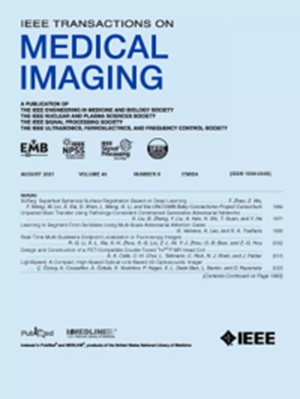Quantifying tumour microvasculature with optical coherence angiography and intravoxel incoherent motion diffusion MRI.
IF 9.8
1区 医学
Q1 COMPUTER SCIENCE, INTERDISCIPLINARY APPLICATIONS
引用次数: 0
Abstract
Intravoxel Incoherent Motion (IVIM) MRI is a contrast-agent-free microvascular imaging method finding increasing use in biomedicine. However, there is uncertainty in the ability of IVIM-MRI to quantify tissue microvasculature given MRI's limited spatial resolution (mm scale). Nine NRG mice were subcutaneously inoculated with human pancreatic cancer BxPC-3 cells transfected with DsRed, and MR-compatible plastic window chambers were surgically installed in the dorsal skinfold. Mice were imaged with speckle variance optical coherence tomography (OCT) and colour Doppler OCT, providing high resolution 3D measurements of the vascular volume density (VVD) and average Doppler phase shift (Δϕ) respectively. IVIM imaging was performed on a 7T preclinical MRI scanner, to generate maps of the perfusion fraction f, the extravascular diffusion coefficient Dslow, and the intravascular diffusion coefficient Dfast. The IVIM parameter maps were coregistered with the optical datasets to enable direct spatial correlation. A significant positive correlation was noted between OCT's VVD and MR's f (Pearson correlation coefficient r = 0.34,p < 0.0001). Surprisingly, no significant correlation was found between Δϕ and Dfast. This may be due to larger errors in the determined Dfast values compared to f, as confirmed by Monte Carlo simulations. Several other inter- and intra-modality correlations were also quantified. Direct same-animal correlation of clinically applicable IVIM imaging with preclinical OCT microvascular imaging support the biomedical relevance of IVIM-MRI metrics, for example through f's relationship to the VVD.用光学相干血管造影和体素内非相干运动扩散MRI定量肿瘤微血管。
体素内非相干运动(IVIM) MRI是一种无造影剂的微血管成像方法,在生物医学中应用越来越广泛。然而,考虑到MRI有限的空间分辨率(毫米尺度),IVIM-MRI量化组织微血管的能力存在不确定性。将转染DsRed的人胰腺癌BxPC-3细胞皮下接种9只NRG小鼠,并在其背部皮肤褶上手术植入与磁共振兼容的塑料窗室。对小鼠进行散斑方差光学相干断层扫描(OCT)和彩色多普勒OCT成像,分别提供血管体积密度(VVD)和平均多普勒相移(Δϕ)的高分辨率3D测量。在7T临床前MRI扫描仪上进行IVIM成像,生成灌注分数f、血管外扩散系数Dslow和血管内扩散系数Dfast的图。IVIM参数图与光学数据集共同注册,以实现直接的空间相关性。OCT的VVD与MR的f呈显著正相关(Pearson相关系数r = 0.34,p < 0.0001)。令人惊讶的是,在Δϕ和Dfast之间没有发现显著的相关性。这可能是由于确定的Dfast值与f相比误差更大,正如蒙特卡罗模拟所证实的那样。其他几个模态间和模态内的相关性也被量化。临床应用的IVIM成像与临床前OCT微血管成像的直接同动物相关性支持了IVIM- mri指标的生物医学相关性,例如通过f与VVD的关系。
本文章由计算机程序翻译,如有差异,请以英文原文为准。
求助全文
约1分钟内获得全文
求助全文
来源期刊

IEEE Transactions on Medical Imaging
医学-成像科学与照相技术
CiteScore
21.80
自引率
5.70%
发文量
637
审稿时长
5.6 months
期刊介绍:
The IEEE Transactions on Medical Imaging (T-MI) is a journal that welcomes the submission of manuscripts focusing on various aspects of medical imaging. The journal encourages the exploration of body structure, morphology, and function through different imaging techniques, including ultrasound, X-rays, magnetic resonance, radionuclides, microwaves, and optical methods. It also promotes contributions related to cell and molecular imaging, as well as all forms of microscopy.
T-MI publishes original research papers that cover a wide range of topics, including but not limited to novel acquisition techniques, medical image processing and analysis, visualization and performance, pattern recognition, machine learning, and other related methods. The journal particularly encourages highly technical studies that offer new perspectives. By emphasizing the unification of medicine, biology, and imaging, T-MI seeks to bridge the gap between instrumentation, hardware, software, mathematics, physics, biology, and medicine by introducing new analysis methods.
While the journal welcomes strong application papers that describe novel methods, it directs papers that focus solely on important applications using medically adopted or well-established methods without significant innovation in methodology to other journals. T-MI is indexed in Pubmed® and Medline®, which are products of the United States National Library of Medicine.
 求助内容:
求助内容: 应助结果提醒方式:
应助结果提醒方式:


